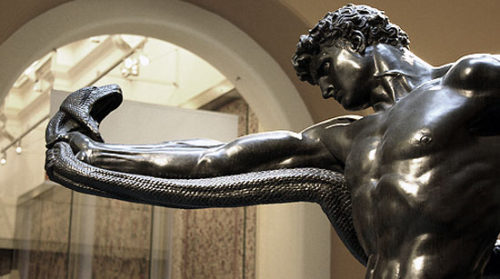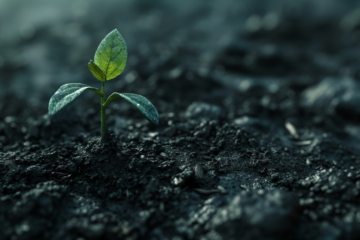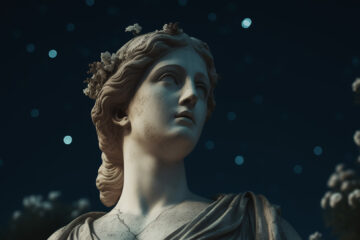The Beauty of Struggle
ONE OF MY favorite activities is hiking in the beautiful mountains of Southern Appalachia. I try to find the most difficult and most remote trails that I can. Being far away from the sound of traffic and the chattering of a rapidly changing racial demographic centers me. Whereas modern urban life is spiritually poisonous, sojourning in the mountains has a purifying effect. Time slows its seemingly rapid pace and the mind begins to think much more clearly. The distractions of a corrupting system no longer dull and distract the senses. One can hear the melodious singing of birds, the rustling of squirrels in the leaves, and the trickle of a stream as it moves, inexorably, to the ocean.
To the bourgeois romantic that one typically passes on these trails, the sights and sounds of Nature are just pretty. Many poems and novels have been written by the more poetic of these individuals. The Romantics, Transcendentalists, and other philosophers are known for waxing poetic about the beauty of Nature. I suppose that I am not really any different in this respect. Idealism is an unmistakable attribute of the higher elements of our race. To be sure, the rare non-White that one encounters on the trail is usually in the company of one of our White idealists. The profound discomfort evident on the faces of most of these dusky companions betrays them. Our race can anthropomorphize animals and sometimes does so to excess — and we also often find ourselves imagining that humans in possession of a very different race-soul think and feel as we do.
But what makes communion with Nature so desirable to us? What makes us idealize beauty within Nature?
My answer came to me while I was taking a hike near the coast. This particular trail led through a salt marsh. So — armed with mosquito repellent, long sleeves, and trousers — I pressed forward. As I walked alongside the marsh, I noticed sleek fish in the water but my eyes were irresistibly drawn to the beautiful white cranes in the distance. I stopped and watched these birds step gracefully through the water. Here and there, they would stop and plunge their bills beneath the surface. Sometimes they would come up with a fish flopping around in their grip and at other times they ended up with nothing. But they would always continue until they caught something worth eating.
I understood then that not only was life itself beautiful, but the struggle to serve the Life Force itself was beautiful.
This idea was reinforced in my mind on a recent trip. A female companion remarked on the beauty of a tree that had grown into a twisted shape. Looking around, I noticed that vines had attached themselves to the surrounding trees. As the trees had grown with the vines wrapped around them, the trunks had twisted into spirals. It was indeed a natural masterpiece. The trees were struggling to reach towards the sky and to expand in order to grow large and reproduce as much as possible. The vines were trying to do much the same thing. Both plants were trying to survive and both had come into conflict in trying to do so. The result of the struggle had left the trees with unique spiral formations. The struggle had left the trees scarred but they were aesthetically pleasing.
When I think back to historical struggles, I can envision the uniform of the Hussar with their embroidered uniforms, flowing capes, and majestic horses. I can also imagine the Waffen SS with their distinctive helmets, Sig Runes on their collar, and the steely look in their eyes. Each struggled. Each fought for home, hearth, and family. The Hussar and the Waffen SS soldier were in the service of the Life Force. For the Aryan, struggle — be it in the realm of plants and animals or in the realm of human affairs — is beautiful. We are a people who idealize warfare as a natural extension of life.
Without struggle, there can be no life. Whether we look upon the farmer who toils in bringing forth life from the soil, the fighter who protects his folk, or the ruler who organizes society; we see that all struggle to preserve life. Each one is engaged in a role that the healthy Aryan considers to be honorable and beautiful. Artists and painters have captured the essences of all three since time immemorial.
Reverence for struggle has disappeared, to a large part, in the folkways of our people. The poison of the Jews and liberal modernity have seen to it that any expression of the survival instinct is considered evil or antisocial. The commonly found bumper sticker sums up the modern death instinct in a single word: COEXIST. This soft, nebulous word encapsulates all of the poison of the Jews and their designs: Its true meaning is the end of struggle, and its fruit is White genocide.
The children of the Arctic Sun are a race who are made stronger through struggle. Blacks and other races biologically more accustomed to a tropical climate are relatively indolent and lazy. When food and water and shelter are more plentiful and the climate is constantly warm, a people do not have to think or plan or work to the same degree as people of the North. When food grows on trees year round and is there for the picking, not much effort or thought is required. The White race evolved in colder climates where planning and hard work were necessary. In the modern West, however, struggle has been removed from the equation and the genetic quality of our people is degenerating. Beauty is rare and heroes hard to find. With rare exceptions, the only “spirituality” left is a sort of egalitarian death cult.
But within a few of the remaining Whites the instinct for beauty and reverence for struggle still remain. The seeds of our rebirth still exist and are now being nurtured by a small but growing elite. In the coming generation, strong White men and women dedicated to the service of the Life Force could sweep away the death-world built by the semi-bestial, the raceless, the mongrels, and their inhuman leaders. That is our hope. Trust not in soothing words of coexistence. Trust not in democracy. Trust instead in our race’s eternal struggle against the forces of death and destruction. If you are one of us, that struggle is engraved on your soul.
* * *
Source: Forging the Iron Will







What’s the name of the sculpture above, and who made it? My guess is that it’s by Arno Breker, but I haven’t seen this particular sculpture before, most pictures of Breker’s sculptures are in black and white and thus appear to have a different finish, and most pictures of his sculptures are taken from different angles.
It’s by Frederic Leighton: Athlete Wrestling a Python (1877). Symbolic, I think, of European Man’s struggle against the parasitic power of the Jews.
See http://www.tate.org.uk/art/artworks/leighton-an-athlete-wrestling-with-a-python-n01754
The struggle of beauty is indeed the hinge-pin of the Aryan character. My mother – a fine Aryan woman of the English persuasion born 1910, believed that the two most important things a person could take into their old age was their mental and physical health – everything else was just incidental – proverbial icing on the cake. In my youth and while at university I was very physically active. I specialized in track and field and power lifting. In those days sports scholarships were non-existent and the only reason for engaging in sport was because it was the masculine thing to do. Now in old age I do not do track and field anymore but I still engage in physical activity – strength training. You gain a great deal… Read more »